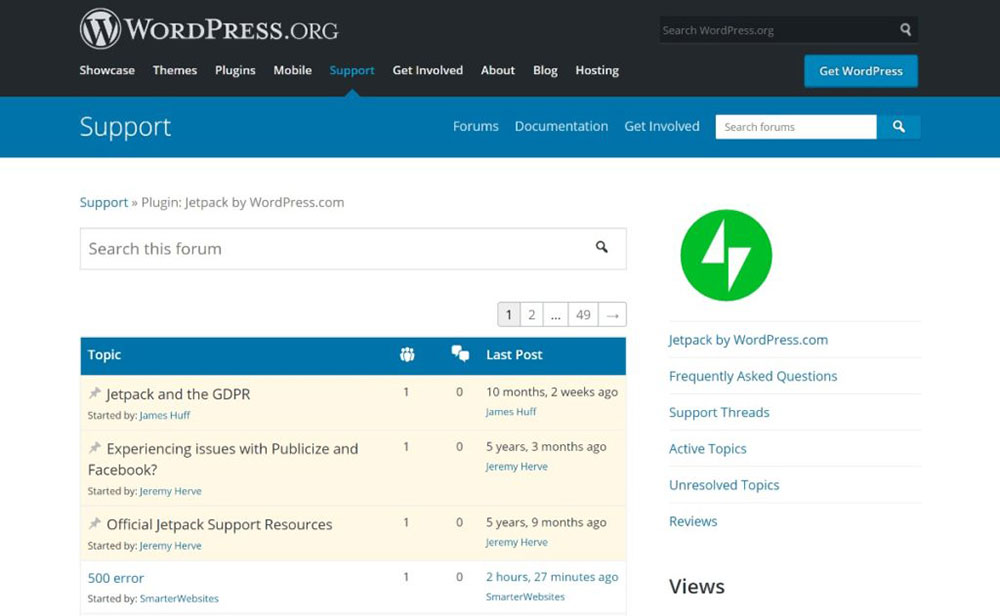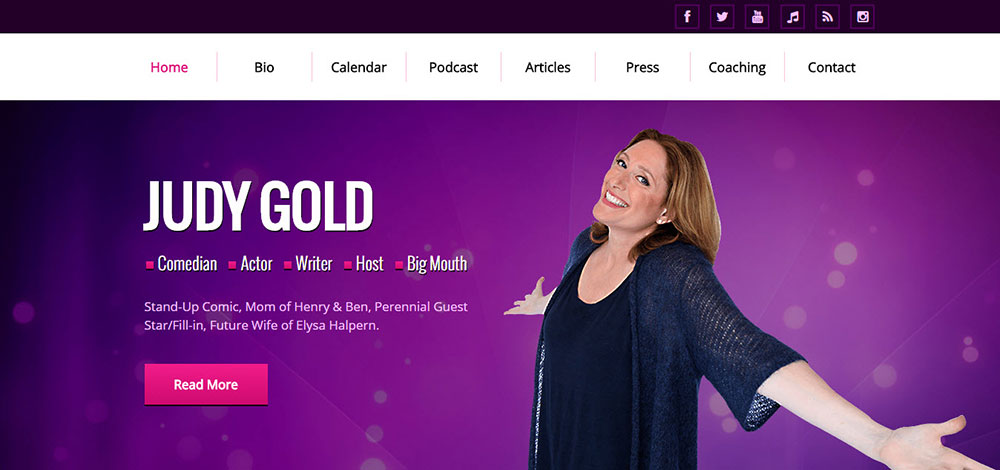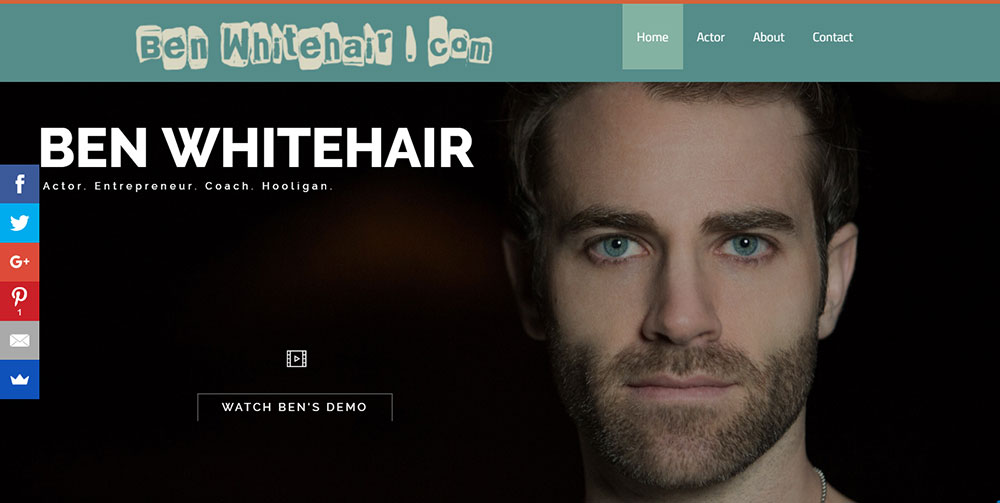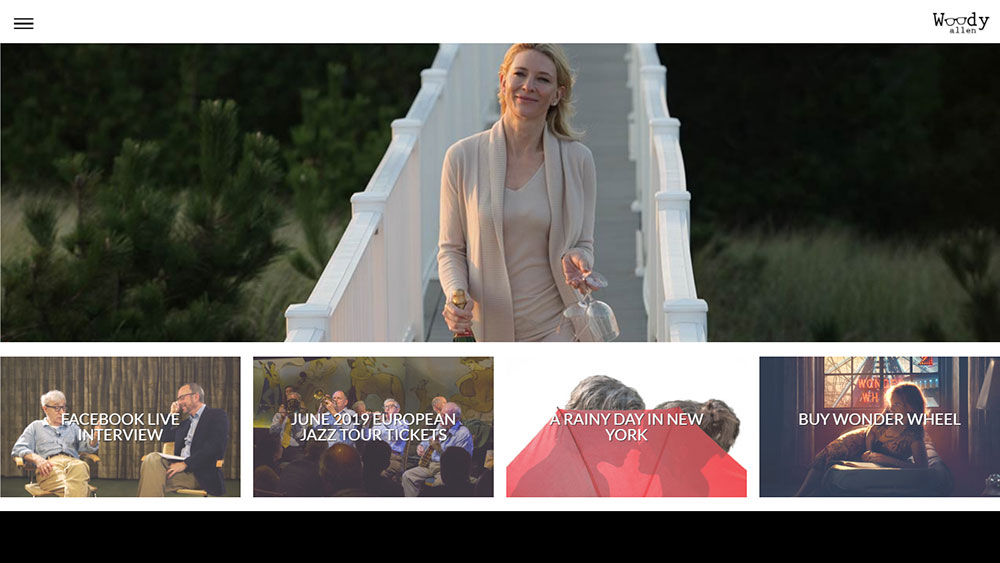
How To Redirect 404 Errors To The Homepage
January 30, 2025
How To Solve The Failed To Open Stream Error In WordPress
February 13, 2025Looking for examples of website actors with good website design? Many performers, from A-list celebrities to theater artists, now recognize the crucial importance of a professional online presence. The digital portfolio serves as their 24/7 talent showcase, accessible to casting directors at CAA, WME, and independent producers globally.
Unlike typical eCommerce sites, actor portfolio websites fulfill a unique purpose. An engaging, professionally designed website allows performers at any career stage to present their credentials effectively. Whether you're a SAG-AFTRA member or an emerging voice actor, your personal site becomes your digital stage.
For acting professionals struggling with visibility, a well-crafted website with integrated showreels and responsive design offers significant advantages. Industry gatekeepers regularly research talent online through platforms like Actors Access and Backstage, but a personal site provides greater control over your presentation.
Your digital presence extends beyond just landing roles. A professional performer website with strong SEO increases discoverability, showcases your range through headshot galleries, and creates a memorable impression with casting networks and fans alike.
Browse our curated selection of exceptional actor websites, from Hollywood stars to Broadway performers, and discover how the right WordPress theme or custom design could transform your career visibility.
Do Actors Need Websites?
When you hear about Leonardo DiCaprio or Emma Stone, what's your first instinct? You Google them.
This behavior applies to everything today. Whether it's:
- A new restaurant downtown
- A drama school instructor
- The voice actor from your favorite animation
Finding nothing online makes people lose interest quickly. The same principle affects performers from Broadway to Hollywood.
For SAG-AFTRA members and theater performers alike, a personal website serves as your always-available digital portfolio. When casting directors from CAA or WME search your name (which they absolutely do), a professional site with integrated showreels immediately signals professionalism.
The hard truth? Without a responsive actor website showcasing your headshot gallery and acting CV, you risk becoming invisible to the industry. Top agents at UTA regularly discover new talent through online presence, not just traditional channels like Casting Networks or Actors Access.
Professional performer websites offer what social media can't: complete control over your presentation, branding, and story. Beyoncé's award-winning site demonstrates this perfectly - it's an extension of her carefully crafted public image.
Your WordPress-powered acting portfolio can include elements impossible to showcase elsewhere:
- Behind-the-scenes footage
- Complete film credits organization
- Press kit downloads
- Integration with IMDb profile
- Mobile-friendly booking forms
Without this digital foundation, even talented screen actors often remain undiscovered.
Top Mistakes Present on Actor Websites
After helping numerous television and commercial actors create their online presence, I've identified common pitfalls that undermine even the most promising talent. Helen Mirren's site avoids these problems beautifully.
Amateur Visual Presentation
Nothing screams "unprofessional" faster than poor design. Your acting career deserves better than templates that look like they're from 2005.
What top performers do instead:
- Commission professional headshot photographers
- Use industry-standard WordPress themes for actors
- Organize performance imagery logically
- Maintain visual consistency with their personal branding
- Structure theater credits display thoughtfully
Los Angeles actors competing for limited roles can't afford amateurish presentation when WME agents are making split-second decisions.
Navigation Nightmares
I clicked away from a Broadway performer's site yesterday after waiting 15 seconds for pages to load. Casting directors from Backstage won't have any more patience.
Bad navigation includes:
- Confusing menu structures
- Slow-loading showreel integration
- Hidden contact information
- Overwhelming visitors with too many options
- Non-mobile responsive layouts
Russell Brand's site demonstrates perfect navigation - everything important is accessible within two clicks.
Your website showing only film credits from 2018 tells visitors you're inactive. New York theater performers particularly suffer from outdated sites.
Avoid:
- Ancient headshots
- Outdated actor biographies
- Missing recent projects
- Broken social media integration
- Non-functioning booking form integration
Stephen Fry updates his site regularly, maintaining visitor interest and industry relevance.
Over-Complicated Language
Character actors sometimes fall into the trap of writing pretentious biographies. Remember: casting directors scan dozens of sites daily and need clear, direct information.
Your acting philosophy section should be authentic but accessible. Woody Allen's site demonstrates perfect balance - intelligent without being overwritten.
Feature Overload
Your dramatic arts online portfolio isn't a tech demonstration. Voice actor websites particularly struggle with this - trying to include every possible feature.
Problematic elements include:
- Autoplaying showreels
- Excessive animation
- Cluttered press mentions layout
- Too many testimonial sections
- Overwhelming social media feeds
London stage actors with effective sites understand restraint - focusing on essential elements that support their casting goals.
Professional Contact Information
Your personal number doesn't belong on your cinematic artist website. Instead, provide:
- Agent contact at agencies like UTA
- Professional email (not personal)
- Contact form with dropdown for inquiry type
- SAG membership information where relevant
- Industry-specific messaging platforms
This approach protects privacy while making you accessible to legitimate Hollywood casting calls.
Strategic Reel Presentation
Embedding videos directly on your site keeps visitors engaged. Avoid sending them elsewhere.
Effective approaches include:
- Categorized reels (comedy, drama, commercial)
- Short-form samples for quick viewing
- Full-length options for detailed review
- Behind-the-scenes material showing versatility
- Technical specifications for downloaded files
Performance video hosting needs thought - balance quality with loading speed.
Mobile Optimization
Over 70% of initial talent searches happen on mobile devices according to Smart Insights. Your thespian online presence must function perfectly on phones.
This means:
- Responsive design that adapts to screen size
- Quick-loading elements
- Touch-friendly navigation
- Readable text without zooming
- Properly sized tap targets for links
Television actor homepages designed without mobile consideration effectively eliminate most spontaneous industry discoveries.
Exclusive Content
Movie star official sites stand out when they offer content unavailable elsewhere. For acting reel hosting, include material that visitors can't find on standard platforms.
Examples include:
- Raw audition footage
- Project development updates
- Training demonstrations
- Personal insights into roles
- Exclusive photoshoots
This approach gives industry professionals and fans reason to bookmark your site.
Current Updates
Keep visitors informed about your professional journey. Even established film actor personal pages need regular refreshes.
A dedicated news section should include:
- Upcoming projects section
- Recent casting announcements
- Training accomplishments
- Industry event participation
- Media appearances
This activity signals to casting directors that you're actively working and developing your craft.
Examples of Actor Websites You Can’t Miss
Leonardo Di Caprio
Leonardo DiCaprio's full-screen slider website stands as one of the best actor digital portfolios in the industry. CAA-represented talent often needs sites that balance personal branding with professional achievements - his does exactly that.
The site features:
- Sleek responsive design that works flawlessly on mobile
- Integrated showreel hosting for his film credits
- Strategic social media integration driving cross-platform engagement
- Clear pathways to his environmental activism
- Professional headshot galleries organized by project
Most importantly, it avoids the common mistake of siloing his work. His TV appearances, film projects, and advocacy all connect through a coherent navigation system that casting directors from major networks can quickly access.
Stephen Fry
Stephen Fry's website offers a masterclass in chronological portfolio organization. Starting with his 1981 theater productions, it methodically showcases his evolution as a performer.
Key features worth studying:
- Clear timeline presentation of London stage performances
- Domain name that uses his full name (a must for performer digital presence)
- WordPress implementation with custom post types for different project categories
- Minimalist actor website design that places content first
- Readable typography that enhances his writing
For thespian online presence, this approach works particularly well when showcasing depth of experience. Drama school graduates should note how cleanly he categorizes theater credits display without overwhelming visitors.
Woody Allen
Woody Allen's official site functions more as a comprehensive brand hub than just an acting portfolio. Built on WordPress (the industry-standard CMS for performer websites), it demonstrates how character actors with directing and writing credits can organize complex career information.
His site excels in:
- Clean presentation of multi-disciplinary work
- Press mentions layout that highlights critical reception
- Clear organization of film chronology
- Integration with IMDb and other industry databases
- Mobile-friendly performer pages that load quickly
The acting CV section particularly stands out, offering casting networks and talent agencies like WME a comprehensive view of his on-screen work separate from his directorial projects.
FAQ on designing actor websites
What's the main purpose of an actor's website?
An actor's website serves as a digital portfolio for CAA and WME talent scouts, independent casting directors, and industry professionals. Unlike social media profiles, your personal site offers complete control over:
- How your headshots appear
- Organization of your acting CV
- Integration of your performance reels
- Specific messaging around your brand
- Direct contact methods for Hollywood casting calls
A well-designed performer digital portfolio works 24/7, showcasing your range to decision-makers at times they actually search for talent - often late at night after auditions.
How often should I update my website?
SAG-AFTRA members should update their sites after each:
New project - Add recent film credits immediately Professional photoshoot - Refresh headshot galleries seasonally Press mention - Update press sections monthly Industry award - Feature achievements prominently Training completion - Add new skills and certifications
Los Angeles actors competing for limited roles must demonstrate recent activity. A site showing no updates since 2022 signals career stagnation to Backstage casting professionals.
What should be the main focus on the homepage?
Your homepage needs instant impact for screen actor digital presence. Include:
- A professional-grade hero image (not a selfie)
- Clear navigation to showreel hosting
- Brief, scannable performance credentials
- One-click access to contact information
- Mobile-friendly design that loads in under 3 seconds
Study Leonardo DiCaprio's homepage layout - it balances visual impact with functional access to critical information. Broadway performer websites particularly benefit from showcasing versatility upfront.
Do I need a blog on my actor website?
A blog works for some actor portfolio websites but hurts others. Consider:
- YES if: You write well, have industry insights, maintain consistent posting (minimum monthly), and integrate with your social media
- NO if: You'll abandon it after three posts, struggle with clear writing, or don't have a specific angle
Stephen Fry's site demonstrates effective blogging - his writing extends his brand. Many theater performer sites feature "news" sections instead, requiring less frequent updates.
How important are visuals in designing actor websites?
Visuals make or break your cinematic artist website. Top considerations include:
- Headshot quality: Professional photography only
- Image optimization: Fast loading on mobile devices
- Gallery organization: Logical categorization by type/role
- Visual hierarchy: Guiding the viewer's eye strategically
- Color scheme: Consistency with your personal branding
Television actor homepages with poor visuals lose visitors in seconds. UTA representatives report spending less than 10 seconds evaluating performer websites initially.
Should I include testimonials or reviews?
Strategic testimonials strengthen voice actor websites and character actor portfolios. Include:
- Quotes from recognized directors
- Feedback from casting professionals
- Press reviews from legitimate publications
- Fellow actor experiences (when from notable performers)
- Acting coach testimonials (selectively)
Avoid anonymous reviews or overly gushing praise. Helen Mirren's website demonstrates perfect balance with verified, specific testimonials.
How do I make my website mobile-friendly?
Mobile optimization is non-negotiable for thespian online presence:
- Use responsive WordPress themes for actors
- Test load speed on actual mobile devices
- Ensure tap targets are properly sized
- Verify text readability without zooming
- Prioritize critical content for small screens
Smart Insights research shows 68% of casting professionals initially check actor websites on phones, not desktops. Your mobile experience often creates first impressions.
What about SEO for actor websites?
Actor website SEO requires targeted strategy:
Must-haves:
- Your full name in title tags, headings, and URLs
- Location-specific terms ("New York theater performer")
- Specialty keywords ("Shakespearean actor," "voice actor commercials")
- Alt text on all headshot galleries
- Structured data markup (schema.org Person)
Avoid keyword stuffing that reads unnaturally. Emma Stone's digital presence demonstrates how proper SEO increases discoverability without sacrificing quality.
How can I integrate my social media?
Social media integration enhances acting career websites when done strategically:
- Display icons linking to professional accounts only
- Consider embedded Instagram feeds for behind-the-scenes content
- Showcase industry-relevant Twitter activity
- Link YouTube channel with performance clips
- Include LinkedIn for industry networking
Russell Brand's website demonstrates effective balance - social media complements but doesn't overwhelm his main content.
Any tips on choosing a domain name?
Your domain name forms your digital identity. For SAG-AFTRA members and aspiring performers alike:
Best practices:
- Use your professional name (FirstnameLastname.com)
- Secure .com extension if possible
- Avoid hyphens, numbers, or acting-specific additions
- Keep it short and memorable
- Register similar variations to protect your brand
If your exact name is unavailable, consider adding "actor" or your location (JohnSmithActor.com or JohnSmithLA.com) rather than choosing an entirely different name.
Conclusion
Looking at these examples of actor websites with good website design, certain patterns emerge. Leonardo DiCaprio, Stephen Fry, and Helen Mirren all maintain websites that balance visual appeal with functional purpose.
Your professional online presence needs these key elements:
- Professional imagery: High-quality headshots and performance photography
- Organized credits: Clearly structured film credits and theater productions
- Responsive design: Mobile-friendly layouts for casting directors on the go
- Direct contact: Professional methods to reach you or your representation
- Current content: Regularly updated news and project information
The digital portfolio has become essential for both established SAG-AFTRA members and aspiring Broadway performers. When talent scouts from CAA, WME or UTA search for new talent, your website often creates their first impression.
WordPress remains the leading CMS for actor websites, offering:
- Flexible templates specifically designed for performer websites
- Easy integration with showreel hosting platforms
- Simple updating systems for even non-technical users
- SEO capabilities to improve visibility in casting searches
- Mobile responsiveness without additional development
Los Angeles actors, New York theater performers, and London stage actors all benefit from strategic domain name selection and thoughtful content organization. The examples we've analyzed demonstrate how proper headshot galleries, integrated IMDb profiles, and clear navigation empower talent discovery.
For voice actors and character actors particularly, the website serves as critical evidence of range and versatility that traditional resumes cannot capture. The performing arts websites showcased here prove that effective online presence directly impacts casting opportunities.













